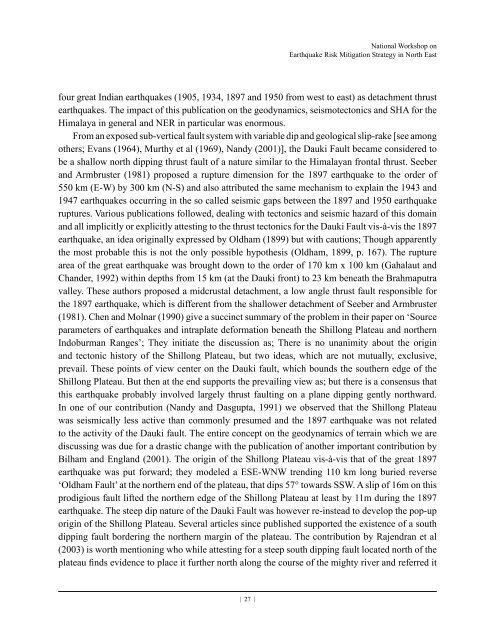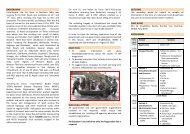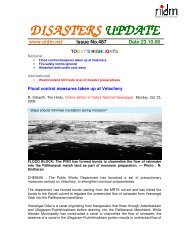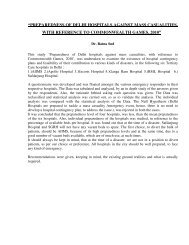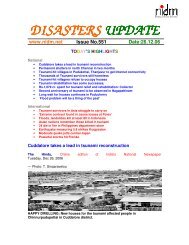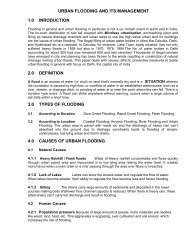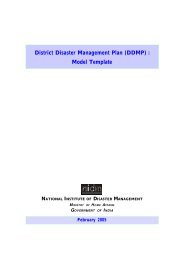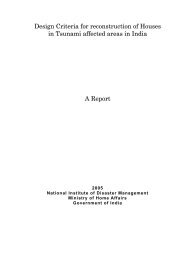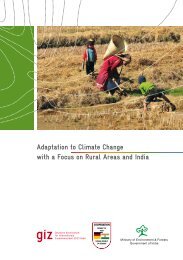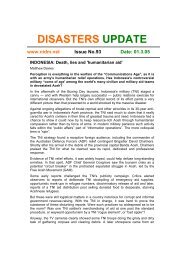Earthquake Risk Mitigation - NIDM
Earthquake Risk Mitigation - NIDM
Earthquake Risk Mitigation - NIDM
Create successful ePaper yourself
Turn your PDF publications into a flip-book with our unique Google optimized e-Paper software.
| 27 |<br />
National Workshop on<br />
<strong>Earthquake</strong> <strong>Risk</strong> <strong>Mitigation</strong> Strategy in North East<br />
four great Indian earthquakes (1905, 1934, 1897 and 1950 from west to east) as detachment thrust<br />
earthquakes. The impact of this publication on the geodynamics, seismotectonics and SHA for the<br />
Himalaya in general and NER in particular was enormous.<br />
From an exposed sub-vertical fault system with variable dip and geological slip-rake [see among<br />
others; Evans (1964), Murthy et al (1969), Nandy (2001)], the Dauki Fault became considered to<br />
be a shallow north dipping thrust fault of a nature similar to the Himalayan frontal thrust. Seeber<br />
and Armbruster (1981) proposed a rupture dimension for the 1897 earthquake to the order of<br />
550 km (E-W) by 300 km (N-S) and also attributed the same mechanism to explain the 1943 and<br />
1947 earthquakes occurring in the so called seismic gaps between the 1897 and 1950 earthquake<br />
ruptures. Various publications followed, dealing with tectonics and seismic hazard of this domain<br />
and all implicitly or explicitly attesting to the thrust tectonics for the Dauki Fault vis-à-vis the 1897<br />
earthquake, an idea originally expressed by Oldham (1899) but with cautions; Though apparently<br />
the most probable this is not the only possible hypothesis (Oldham, 1899, p. 167). The rupture<br />
area of the great earthquake was brought down to the order of 170 km x 100 km (Gahalaut and<br />
Chander, 1992) within depths from 15 km (at the Dauki front) to 23 km beneath the Brahmaputra<br />
valley. These authors proposed a midcrustal detachment, a low angle thrust fault responsible for<br />
the 1897 earthquake, which is different from the shallower detachment of Seeber and Armbruster<br />
(1981). Chen and Molnar (1990) give a succinct summary of the problem in their paper on ‘Source<br />
parameters of earthquakes and intraplate deformation beneath the Shillong Plateau and northern<br />
Indoburman Ranges’; They initiate the discussion as; There is no unanimity about the origin<br />
and tectonic history of the Shillong Plateau, but two ideas, which are not mutually, exclusive,<br />
prevail. These points of view center on the Dauki fault, which bounds the southern edge of the<br />
Shillong Plateau. But then at the end supports the prevailing view as; but there is a consensus that<br />
this earthquake probably involved largely thrust faulting on a plane dipping gently northward.<br />
In one of our contribution (Nandy and Dasgupta, 1991) we observed that the Shillong Plateau<br />
was seismically less active than commonly presumed and the 1897 earthquake was not related<br />
to the activity of the Dauki fault. The entire concept on the geodynamics of terrain which we are<br />
discussing was due for a drastic change with the publication of another important contribution by<br />
Bilham and England (2001). The origin of the Shillong Plateau vis-à-vis that of the great 1897<br />
earthquake was put forward; they modeled a ESE-WNW trending 110 km long buried reverse<br />
‘Oldham Fault’ at the northern end of the plateau, that dips 57° towards SSW. A slip of 16m on this<br />
prodigious fault lifted the northern edge of the Shillong Plateau at least by 11m during the 1897<br />
earthquake. The steep dip nature of the Dauki Fault was however re-instead to develop the pop-up<br />
origin of the Shillong Plateau. Several articles since published supported the existence of a south<br />
dipping fault bordering the northern margin of the plateau. The contribution by Rajendran et al<br />
(2003) is worth mentioning who while attesting for a steep south dipping fault located north of the<br />
plateau finds evidence to place it further north along the course of the mighty river and referred it


